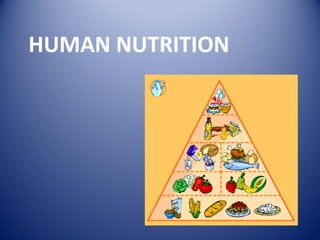
Human nutrition
- 2. What is the difference? FEEDING NUTRITION
- 3. HUMAN NUTRITIONHUMAN NUTRITION • NUTRITIONNUTRITION is the set of processes that allows the body tois the set of processes that allows the body to obtain from food the substances (nutrients) needed toobtain from food the substances (nutrients) needed to live, transport them through the body, and eliminate thelive, transport them through the body, and eliminate the toxic substances produced by our cells when using thosetoxic substances produced by our cells when using those nutrients.nutrients. Autora: Marta García T.Autora: Marta García T.
- 4. SYSTEMS INVOLVED IN NUTRITIONSYSTEMS INVOLVED IN NUTRITION Autora: Marta García T.Autora: Marta García T.
- 5. Autora: Marta García T.Autora: Marta García T.
- 6. SYSTEMS INVOLVED IN NUTRITIONSYSTEMS INVOLVED IN NUTRITION • Digestive System: transforms food into nutrients which can be used by our cells.. • Respiratory System: captures oxygen and eliminates carboncaptures oxygen and eliminates carbon dioxidedioxide.. • Circulatory System: transports substances through the body. • Excretory System: eliminates waste susbtances produced byeliminates waste susbtances produced by our cells.our cells. Autora: Marta García T.Autora: Marta García T.
- 8. Glycerol Fatty Acid Fatty Acid Fatty Acid Glycerol Fatty Acid Fatty Acid Fatty Acid Lipase Fat Fatty Acids and Glycerol
- 9. NUTRIENTS Nutrients are substances that our body needs to build new structures, and to obtain the energy we need. We obtain them from food. 1) Organic: glucids, lipids, proteins, vitamins. 2) Inorganic: water, mineral salts.
- 10. SUGARS • Give us energy and make up structures. – Simple: sweet and crystalline, soluble in water. They can be used directly. Ex. Glucose, Lactose. – Complex: neither sweet nor crystaline. Made of many simple sugar molecules joined together. They must be broken down for using them. Ex. Starch, Cellulose.
- 11. LIPIDS • Insoluble in water. Oily appearence. • They store energy and make up structures. • Three types: – Fats: Saturated / Insaturated. – Regulatory Lipids. – Membrane Lipids.
- 12. PROTEINS • Made up of simple molecules called Amino Acids (20). • Carry out different functions: – Antibodies. – Haemoglobin. – Keratine.
- 13. VITAMINS • Can be lipids or glucids. • Vital for the correct functioning of the body. • They are needed in very small quantities. • They can be easily destroyed by heat, light and oxygen. • 2 types: – Liposoluble. – Hydrosoluble.
- 14. MINERAL SALTS • Make up structures, carry out chemical reactions, trasmit the nervous impulse. • Present in fruits, vegetables and water.
- 15. WATER • 65% of our body mass. • Solvent, transports substances, regulates temperature, medium for chemical reactions. • 2,5 litres per day.
- 16. APORTES ENERGÉTICOS Lípidos: 9 Kcal/gr Glúcidos: 4 Kcal/gr Proteínas: 4 Kcal/gr
- 17. FOOD GROUPS 1. Energetic Food. 2. Regulatory Food. 3. Structural Food (Raw Materials).
- 19. THE FOOD PYRAMID
- 20. What do we use energy for? • Mitochondria burn nutrients to produce: – Thermal Energy. – Chemical Energy. – Mechanical Energy.
- 21. NECESIDADES ENERGÉTICAS - Hombres: 2500 Kcal/día. - Mujeres: 2200 Kcal/día. Dependiendo de: - Edad. - Actividad física. - Estado de salud.
- 22. DIETS A diet refes¡rs to the quantity and type of food we consume daily. To have a balanced diet: - Several times a day. - Variety. - Fresh food. - Unsaturated fats. - Reduce saturated fats.
- 24. SPECIAL DIETS • Low / High calorie diet. • Low cholesterol diet. • High-fibre diet. • Low-fibre diet.
- 25. ENFERMEDADES DE ORIGEN ALIMENTARIO • Malnutrición: desnutrición / sobrenutrición. • Intoxicaciones alimentarias.
- 26. Food Labels • Quantity. • Nutritional information. • Dates: Best-before / Expiration date. • Ingredients. • Storage instructions.
- 28. FOOD STORAGE AND HANDLING • Preservation by Cold: reproductive speed is reduced. Refrigeration or Freezing. • Preservation by Dehydration: eliminate water from food. It stops the development of microorganisms.
- 29. • Preservation by Heating: heat kills microorganisms: – Pasteurization: up to < 100 ºC a few seconds cool down quickly. Needs preservation. – Sterilization: > 100 ºC. More lasting preservation.
- 30. • Preservation by Substances Addition: incorporation of different substances into the food to stop microorganisms’ development.
- 31. ADITIVOS ALIMENTARIOS Son sustancias que se añaden a los alimentos para prolongar su conservación o mejorar sus propiedades. Tipos: - Colorantes. - Conservantes. - Antioxidantes. - Edulcorantes. - Potenciadores del sabor. - Espesantes, gelificantes…